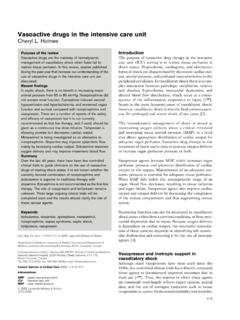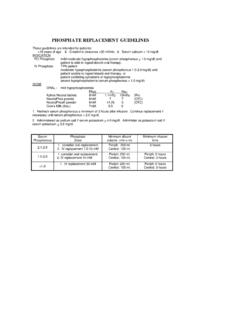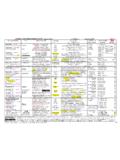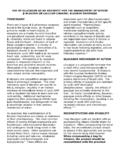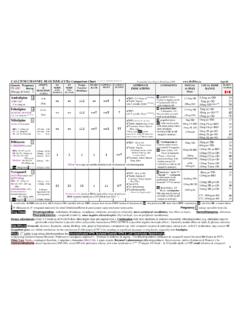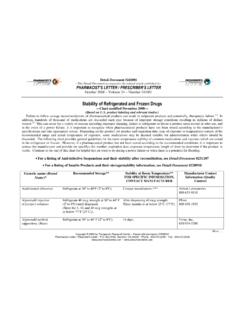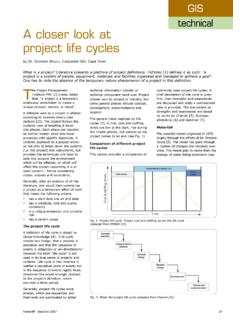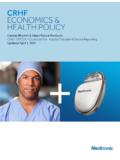Transcription of GUIDELINES FOR Extended Interval …
1 140 - age)( IBW) x if female (72) (serum Cr) GUIDELINES FOR Extended Interval gentamicin /Tobramycin Dosing/Monitoring in ADULT patients Legacy Health System 2002 1. These GUIDELINES are NOT to be used in: Patients with severe renal disease (CrCl<30ml/min) or requiring dialysis. Use traditional kinetics to calculate an appropriate dose. Patients with gram positive infections where aminoglycoside is used for synergy Enterococcal Endocarditis (multiple doses/day more effective) Neonates or pediatric patients Pre-op surgical prophylaxis Patients with a history of allergy to aminoglycosides Patients with a history or signs of a hearing loss or vestibular dysfunction Deteriorating renal function 2.
2 These GUIDELINES should be used with caution in: Patients with chronic ascites or serious liver disease Pregnancy (no data on fetal pharmacokinetics and toxicity) Patients with rapid clearance of drug ( cystic fibrosis, burns>20% of BSA) Patients who have received multiple courses of aminoglycosides in the past 3. Dosing gentamicin and tobramycin Utilize aminoglycoside dosing calculator on pharmacy website: Fill in required information (pt name, sex, location, weight, height, age, SrCr, Vd (normal or large Vd which may include burn, postpartum, leukemia, trauma, cystic fibrosis, and edema) and time of infusion (60min for QD dosing, 30min with traditional dosing) Select An appropriate peak and trough and fill in those blanks.)
3 Goal peak: >10 x MIC for maximize efficacy. Examples of target maximum serum concentrations (Cmax) based on infection: moderate(Cmax14-16mcg/ml), severe (Cmax 16-20mcg/ml). Also consider susceptability of infecting organism. Note these target levels are much higher than with conventional dosing (goal peak 4-10 depending on site of infection., goal trough <2. See Global RX website for specific recommendations) Goal trough: "0"mcg/ml at 24 hours. A drug-free Interval of 3 - 5 hours minimizes toxicity and permits the reversal of the adaptive post-exposure resistance. (goal trough < for at least 4 hours).
4 Goal 12 hour level around 3mcg/ml Select a "realistic dose" and Interval based on the information provided by the calculator. Adjust the dose to achieve the goal levels as above Once completed, print out the calculator information and attach it to the pharmacy monitoring sheet or use as part of your chart note. If a dosing Interval longer than 48 hours would be necessary to achieve a drug free Interval of 3-5 hours, then an alternative antimicrobial agent should be considered. Also, in patients with high clearance ( , young adults, cystic fibrosis, burns, etc) dosing intervals shorter than 24 hrs may be more appropriate to prevent treatment failure caused by prolonged (>4hr) drug free periods.
5 IF pharmacy website is down, a reasonable dose can be determined by: Calculate IBW: IBW (females) = + ( x inches > 60) IBW (males) = 50 + ( x inches > 60) Calculate adjusted weight if obese (actual weight > 20% over IBW) Adj BW = IBW + (actual BW - IBW) Calculate Creatinine Clearance (ml/min) using IBW = Determine if normal Vd or Large Vd (patients with large Vd may include burn, postpartum, leukemia, trauma, cystic fibrosis, and edema) Calculate Dose based on actual body weight OR adjusted weight if obese using table below: Round dose to the nearest 10mg, Administer over 60 minutes **When dosing/monitoring.
6 Always consider site/type of infection and patient's other disease states/risk factors Estimated CrCl Normal Vd Large Vd Dosing Interval >80ml/min 5mg/kg 7mg/kg q24h 60-79ml/min 4mg/kg q24h 50-59ml/min 5mg/kg q24h 30-49ml/min q24h <30ml/min calculate dose with traditional kinetics 4.
7 Aminoglycoside levels: a. When to order levels: Aminoglycoside serum concentration MUST be obtained with first dose if: o Creatinine Clearance < 50ml/min o Intensive Care Unit patient (except one time doses) o Severe infection o Patient on concomitant nephrotoxic drugs ( amphotericin, cyclosporine, vancomycin) o Patient at higher risk for acute renal failure (received contrast media in the prior 72 hours, age>65yo, diabetic, underlying renal dysfunction, received multiple courses of aminoglycoside in the past) Must obtain aminoglycoside level later in therapy if: o Patient maintained on therapy 5 days o Renal function changes (SrCr increases by above baseline) Consider DC aminoglycoside in this patient o After any dose change that was based on a previous high or low level o Plan to send home for continued therapy (obtain prior to DC) Repeat level at least every 7 days for patients on long term therapy b.
8 When to draw level: Draw one level 12 hours after start of infusion Draw two levels if expect patient to exhibit unusual kinetics (fast clearance, large Vd) 6 and 13 hours in order to perform kinetic calculations c. Interpreting levels Specifically timed drug levels ( 12hr ) should be plotted on the dosing nomogram graph (goal at 12hours ( 3mg/L). If level draw right at 12hr, use table below. Levels draw at other times can be interpreted based on the nomogram graph. This table/graph requires the Interval be lengthened for high levels. Alternatively, the dose could be decreased to allow for a drug free Interval .)
9 If 12hr level (1hr infusion + 11hr) is < 3 continue q24h dosing If 12hr level is 3 - 5 change to q36h dosing If 12hr level is 5 - 7 change to q48h dosing If 12hr level is > 7 DC protocol and switch to traditional dosing Any level drawn 4 hours prior to the next dose should be near zero (<<1 mg/L) to allow for a drug free period. If level near zero, continue same dose and Interval . If level >1mg/L, extend dosing Interval . 5. Routine Monitoring GUIDELINES : a. Is the patient getting better (WBC decreasing, temp decreasing, etc)? b. Serum Creatinine and BUN.
10 Obtain at baseline and at least every 3 days c. CBC w/diff d. Temperature curve e. Daily in/out record f. Culture results g. Addition of potentially nephrotoxic agents or contrast media h. Signs of vestibular/auditory dysfunction if on therapy >5 days (dizziness, nausea, tinnitis, sense of fullness in the ears, hearing loss). Notify physician to consider DC of the aminoglycoside should these symptoms occur. i. What is the projected course of therapy (long term)? 6. Required documentation/communication: a. Initiation and completion of pharmacokinetic monitoring form b.
